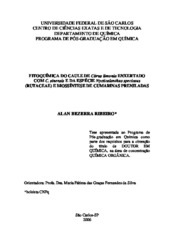| dc.contributor.author | Ribeiro, Alan Bezerra | |
| dc.date.accessioned | 2016-06-02T20:34:13Z | |
| dc.date.available | 2009-10-23 | |
| dc.date.available | 2016-06-02T20:34:13Z | |
| dc.date.issued | 2006-10-19 | |
| dc.identifier.citation | RIBEIRO, Alan Bezerra. PHYTOCHEMISTRY OF Citrus sinensis GRAFTING ONTO C. limonia AND OF THE Nycticalanthus specious SPECIES (RUTACEAE) AND THE BIOSYNTHESIS OF PRENYLATED COUMARINES. 2006. 300 f. Tese (Doutorado em Ciências Exatas e da Terra) - Universidade Federal de São Carlos, São Carlos, 2006. | por |
| dc.identifier.uri | https://repositorio.ufscar.br/handle/ufscar/6129 | |
| dc.description.abstract | The Cravo lime species (C. limonia) acts as the grafting host, mostly used in the Brazilian citriculture and because of its precocious productivity, besides its good adaptation to most common soils, permitting for an optimum harvest. With the aim to contribute to the chemical knowledge of these graftings and to better understand its mechanisms, a phytochemical study of the rootstock from C. sinensis onto C. limonia were carried out. Earlier studies indicated the presence of a remarkable amount of prenylated compounds in the lower part of the C. sinensis graft, onto the C. limonia, while at the same time in the upper part these compounds was found in a very small amounts, rising to the assumption that these compounds could have been translocated from the host to the introduced graft species. In this way, biosynthetical studies of prenylated coumarines were also carried out aiming to evaluate the activity of the prenyltransferase enzyme, responsible by the incorporation of the isoprene units in these compounds. With the objective to advance our knowledge and chemical profile of the Rutaceae family, in which the Citrus genus is inserted. This study also describes the phytochemical and phytosystematics of the Nycticalanthus specious species pertaining to the same family. In the study of the rootstock, several different chromatographic methods were applied permitting to identify nine substances one of them being an unpublished flavanone. From the Nycticalanthus speciuous, eleven compounds were isolated as well as an indolopiridoquinazolic alkaloid and also three limonoids previously unheard of. The isolated compounds from the rootstock were assayed against the fungus Guignardia citricarpa, responsible for the black stains in Citrus species , with the objective to find a possible antifungus for this disease. Two coumarines showed premissory inhibitory activities. The biosynthetical study carried out with the prenyltransferase enzyme DMAPP, Umbelliferone and Herniarin showed that the translocation of the pyranocoumarine Xanthylentin should have happened. Seen in the different parts of the grafting of C. sinensis onto the C. limonia the enzyme were active only in the roots and with this observation, it appears that the coumarine is being metabolized in the lower part and translocated to the upper parts of the graft. | eng |
| dc.description.sponsorship | Universidade Federal de Sao Carlos | |
| dc.format | application/pdf | por |
| dc.language | por | por |
| dc.publisher | Universidade Federal de São Carlos | por |
| dc.rights | Acesso Aberto | por |
| dc.subject | Produtos naturais | por |
| dc.subject | Cumarinas | por |
| dc.subject | Biossíntese | por |
| dc.subject | Citrus limonia | por |
| dc.title | Fitoquímica do caule de Citrus limonia enxertado com C.
sinensis e da espécie de Nycticalanthus speciosus (RUTACEAE) e biossíntese de cumarinas preniladas | por |
| dc.title.alternative | PHYTOCHEMISTRY OF Citrus sinensis GRAFTING ONTO C. limonia AND OF THE Nycticalanthus specious SPECIES (RUTACEAE) AND THE BIOSYNTHESIS OF PRENYLATED COUMARINES | eng |
| dc.type | Tese | por |
| dc.contributor.advisor1 | Silva, Maria Fátima das Graças Fernandes da | |
| dc.contributor.advisor1Lattes | http://lattes.cnpq.br/0457632122660653 | por |
| dc.description.resumo | O limão Cravo (C. limonia) é o porta-enxerto mais utilizado na citricultura brasileira por sua alta e precoce produtividade, além de sua boa adaptação aos tipos mais comuns de solo e grande resistência à seca, permitindo um maior aproveitamento da safra. Visando complementar o conhecimento químico de enxertos e entender melhor sobre o mecanismo dos mesmos, realizou-se neste trabalho estudo fitoquímico do caule de C. limonia enxertado com C. sinensis. Estudos fitoquímicos iniciais mostraram a presença de uma maior quantidade de compostos prenilados na parte inferior do enxerto de C. sinensis sobre C. limonia enquanto que na parte superior do mesmo apenas dois compostos prenilados foram encontrados em poucas quantidades, levando a supor que esses compostos estejam sendo translocados do porta-enxerto para o enxerto. Dessa forma, realizou-se ainda estudo biossintético de cumarinas preniladas para avaliar a atividade da enzima preniltransferase, responsável pela incorporação de unidades isoprênicas nesses compostos, com o intuído de confirmar se há translocação dos mesmos no enxerto estudado. Com o objetivo de se avançar no conhecimento do perfil químico da família Rutaceae, na qual se insere o gênero Citrus, este trabalho descreve também o estudo fitoquímico e quimiossistemático da espécie Nycticalanthus speciosus pertencente à mesma família. O estudo fitoquímico do porta-enxerto envolveu diferentes métodos cromatográficos e permitiu identificar nove substâncias, sendo uma flavanona inédita, e da espécie Nycticalanthus speciosus, foram identificados onze substâncias sendo um alcalóide indolopiridoquinazolínico e três limonóides inéditos. As substâncias isoladas do porta-enxerto foram ensaiadas frente ao fungo Guignardia citricarpa causador da Mancha preta dos citros com o objetivo de se obter um possível antifúngico contra esta doença, sendo que duas cumarinas mostraram atividades inibitórias promissoras. O estudo biossintético da enzima preniltransferase realizado com DMAPP, Umbeliferona e Herniarina mostrou que deve estar ocorrendo a translocação da piranocumarina xantiletina, visto que nas diferentes partes do enxerto de C. sinensis sobre C. limonia a enzima se mostrou ativa apenas nas raízes e com isso essa cumarina está sendo metabolizadas nas partes inferiores e translocada para as partes superiores do enxerto. | por |
| dc.publisher.country | BR | por |
| dc.publisher.initials | UFSCar | por |
| dc.publisher.program | Programa de Pós-Graduação em Química - PPGQ | por |
| dc.subject.cnpq | CIENCIAS EXATAS E DA TERRA::QUIMICA | por |
| dc.contributor.authorlattes | http://lattes.cnpq.br/1660039142489971 | por |
